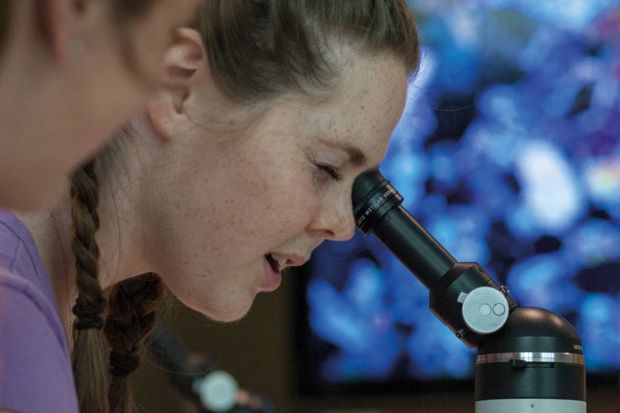Kim Cassidy, the new president of the women’s liberal arts college Bryn Mawr, based in Pennsylvania, never set out to become a university leader.
However, when Jane McAuliffe stepped down in June 2013 after five years in the post, it was Professor Cassidy who was promoted to interim president, before the role was made permanent in February this year.
“Jane and I worked closely over the transition, she was wonderfully helpful,” Professor Cassidy told Times Higher Education. “She put me in a position to be successful and keep things moving. I feel really lucky to have followed her.”
Professor McAuliffe’s tenure was the shortest of any Bryn Mawr president to date, and reports at the time suggested that her departure was unexpected. Professor Cassidy conceded that one of her first roles as interim president was rebuilding relationships with some faculty members.
“The first thing I did was spend two or three months in meeting after meeting, listening and going over the strategic plan with people, and prioritising what we should be focusing on,” she said. “We went over it again and again.
“One of the big pieces of the plan is preparing students for global engagement, and faculty are on board with that. But because it was rolled out as something new, and perhaps wasn’t attentive enough to faculty research interests, we have to re-engage them. There is a lot of that kind of work that has to go on.”
A developmental psychologist with a focus on cognition and education, Professor Cassidy has spent her whole academic career at Bryn Mawr, joining as a faculty member in 1993 before becoming provost in 2007.
Improving access
The college, which has about 1,300 female undergraduates and 400 students in its co-educational graduate school, has a reputation for producing successful female scientists – a record that has caught the eye of US president Barack Obama, who recently held a White House summit on improving access to higher education among underrepresented groups.
Bryn Mawr was invited to the summit because of its participation in the Posse Foundation, a scheme in which a group of 10 students from typically disadvantaged areas are given six months of preparation before they start at the university on means-tested scholarships, in order to help them adapt to life at a prestigious college. This autumn, the institution will welcome its first “STEM posse”; a group of 10 girls who have been selected because of their potential in science, technology, engineering and mathematics.
“Bryn Mawr has one of the highest rates of women science and maths majors percentage-wise in the country,” Professor Cassidy explained. “The White House [is] very interested in getting students from under-represented groups, including first-generation college students and low-income students, into the sciences. They want to know what we are doing that could translate to students more broadly.”
Lack of hard data
However, she admitted that pinning down why Bryn Mawr does so well at encouraging women into science remains a mystery.
“If you asked me what the three things are that Bryn Mawr does that mean we are really good at turning out women scientists, I couldn’t tell you for sure,” she said. “We could make up some stuff and say ‘we are pretty sure it’s this’, but we don’t have data to show that one thing is having more of an impact versus something else. Is it simply that because we’re good at it, we attract good women scientists, or is there something proactive that we are doing?”
Professor Cassidy believes it is the latter, and points to the fact that all Bryn Mawr students are required to spend time in the laboratory as one way the college actively encourages women to consider a science major.
At 56 per cent, the college has a “slightly higher” proportion of women faculty than the national average, Professor Cassidy continued, and even suggested that the lab benches, which are not as high as at other universities in order to accommodate shorter female students, could contribute.
“There could be some accidental things that we’ve done that are really helping, and I want to find out what they are.” However, it was the absence of men that ultimately allowed Bryn Mawr women to flourish, she said.
“We don’t go around saying ‘you are a woman and you can be a scientist’, it’s in the water here. That’s the default. Who is going to be the leader in the lab, who is going to raise their hand, who’s going to talk? It’s women. There is no other option and so nobody makes a big deal of it because it is just the way it is.”
Register to continue
Why register?
- Registration is free and only takes a moment
- Once registered, you can read 3 articles a month
- Sign up for our newsletter
Subscribe
Or subscribe for unlimited access to:
- Unlimited access to news, views, insights & reviews
- Digital editions
- Digital access to THE’s university and college rankings analysis
Already registered or a current subscriber? Login





